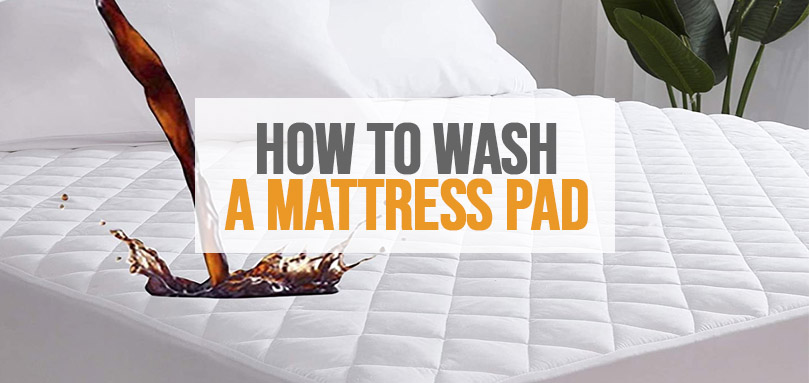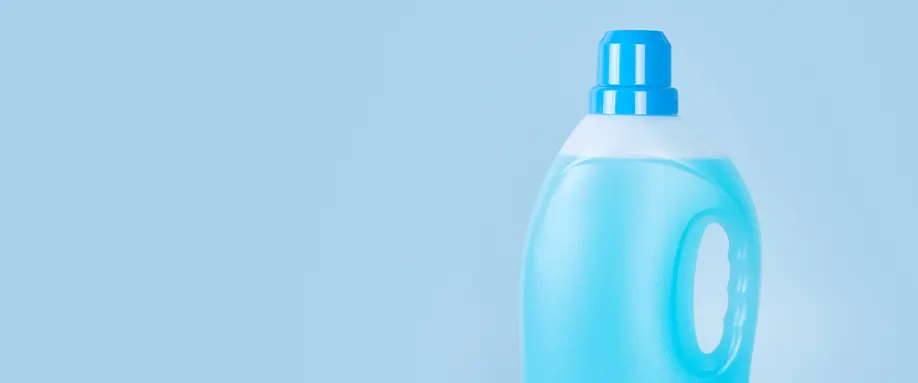How often should I wash my mattress pad?
First, let's answer the question of how often you should wash your mattress pad. While it's not on the front lines of battle (like your bed sheets), they do still soak in a lot of dirt. So, at the bare minimum, you should be cleaning a mattress pad once a year.
However, it's much better to play it safe and do it every 3-4 months. And this goes without saying, but if you happen to spill something on the mattress pad, clean it right away.
And the final scenario I want to cover is if you have allergies and/or live with pets. In this case, you will have to gauge yourself how frequently you get flare-ups and go from there. In severe cases, you might even need to wash your mattress pad every week or so.
How To Wash A Mattress Pad & Make It New?

Be it through mattress pads, mattress protectors, or mattress toppers, it's always a good idea to protect your mattress from stains and prolong its shelf life.
However, the mattress pad needs to be cleaned as well! So, today we're going to go over all mattress pad varients and discuss how you can keep them clean! For a start:
SKILL LEVEL REQUIRED: 2/5.
REQUIRED WORKING TIME: 1-2 hours work, 8+ hours to complete.
TOOLS/EQUIPMENT YOU NEED:
- Vaccum
- Spray bottle
- Destiled white vinegar
- Lemon juice
- Enzyme-based cleaner
- Water
- Mild low-sudsing laundry detergent
- Down solution
- Mild detergent
- Washing machine
- Drying machine.
Cleaning a cotton mattress pad
The first step for all of these different mattress pads is to read the cleaning instructions on the label. After all, nobody knows how to clean a mattress pad better than the person who made it. And since cotton mattress pads are particularly tricky and have to be cleaned multiple times a year, this is information you want to have.
Now that that's out of the way, let's go over the most general approach you should have. First off, take a vacuum (preferably with the brush attachment) and get rid of any debris or clumps that might have fallen on the mattress pad.
Then, throw it into the washing machine, with warm or cool water and mild detergent. Again, you want to consult the label on the product to find out the specifics.
After that, if the label allows it, tumble dry at the lowest temperature. It also helps to throw in rubber drying balls to keep the mattress pad fluffy. But if you don't have any, tennis balls will work as well.
And if machine drying is not an option, simply air dry it outside. Either way, make sure that every part of the mattress pad is completely dry before putting it back on the mattress so that it can't accumulate mould.
Cleaning a vinyl-backed mattress pad
Often used for mattress protectors, vinyl tends to have a waterproof membrane, and can thus just be wiped down. However, when it comes to vinyl-backed mattress pads, that's only half the story – as there's still cotton involved as well.
So, first things first, check whether you can machine wash it. Most vinyl-backed mattress pads can be machine-washed, but it never hurts to make sure. Using cold or warm water, set the washing machine on a gentle cycle and use a mild detergent.
And just like with cotton mattress pads, if possible, throw it into a tumble dryer on low heat and toss in dryer/tennis balls so that the pad can keep its fluff. If not, dry it outside or set it on a clean surface in the house with proper ventilation, flipping it every few hours so that it dries evenly.
Either way, you want to dry the vinyl side first and then flip it over to dry the cotton side. And once you're positive it's completely dry throughout, you can place it back onto the bed.
Cleaning a foam mattress pad
In terms of cleaning, memory foam pads are by far the most complicated. Unlike the previous two entries, you can't just toss a foam mattress pad into a washing machine, as the foam would be damaged beyond repair. To this point, some people even suggest throwing your foam mattress pad out and getting a new one once it gets too dirty.
But if you were to clean it, this is what the process would look like. First off, use a vacuum and get rid of any dirt clumps that might have formed on either side of the foam mattress pad. Then, ideally, you'd just want to stick to spot cleaning. To do this, use an enzyme-based cleaner, and starting from the outside of the stained area, work in circles towards it. If you don't have any enzyme-based cleaner on hand, you can also use a solution of equal part water, distilled white vinegar and lemon juice.
Once either the solution or the enzyme-based cleaner has been applied, let them sit for about twenty minutes and then use a wet sponge to gently clean it up, making sure to dab and not rub. Lastly, dab the foam mattress pad with a clean cloth or towel until dry.
And if spot cleaning isn't possible and the entire surface needs a deeper cleaning, repeat the process, rinse lightly with a hand-held shower head and let it air dry. You could also use a different solution – with one part mild, low-sudsing laundry detergent to two parts water and then clean it in the manner described.
Cleaning an egg crate mattress pad
Egg crate mattresses are prime opportunities for crumbs and dust mites to hide in. So, the most obvious first step is to vacuum both sides of the egg crate mattress pad. You can also remove all the padding from the pad and simply shake off any unwanted dirt and crumbs.
But if there are any stains, then you have to clean it like a foam pad – so, a bit more work could be required. However, you might be lucky as some manufacturers do in fact make egg crate mattress pads that are sturdy enough for machine washing – just check the care label. If you're in luck, you can use a commercial or oversize washing machine, putting it on a delicate cycle and using mild detergent to get the job done.
If not, you can use the same spot-cleaning method as with foam mattress pads – making sure to dab and use either the equal part water, distilled white vinegar and lemon juice solution or the enzyme-based cleaner.
Cleaning a down mattress pad
The first two steps for cleaning a down mattress pad are the same as with all the previous pads. Use a vacuum to get rid of any crumbs or dirt, and check the care label to see whether it's machine washable.
If the down mattress pad can be washed in a machine, first check it for any rips (so you don't end up with feathers everywhere) and then use a front loading washer, put it on a delicate cycle with cool water and either a low-sudsing detergent or a special down cleaner.
And if the pad has noticeable stains, it's best to rub them down with some detergent or down cleaner prior to the wash so they come out more easily. Just make sure to let the solution sit for about 20 minutes and you should be alright.
And when it comes to drying the pad, the usual tactic of setting the drier to low heat and throwing in drier/tennis balls will do the trick. However, do also make sure to pull the pad out of the drier every fifteen minutes or so in order to fluff it up and remove any clumps that may have formed.
Steps for cleaning a mattress pad
Just so that we're all on the same page, let's go over the basic steps once more. And to reiterate, always check the care label to see whether these methods apply to your product.
How To Wash A Mattress Pad & Make It New?

Be it through mattress pads, mattress protectors, or mattress toppers, it's always a good idea to protect your mattress from stains and prolong its shelf life.
However, the mattress pad needs to be cleaned as well! So, today we're going to go over all mattress pad varients and discuss how you can keep them clean! For a start:
SKILL LEVEL REQUIRED: 2/5.
REQUIRED WORKING TIME: 1-2 hours work, 8+ hours to complete.
TOOLS/EQUIPMENT YOU NEED:
- Vaccum
- Spray bottle
- Destiled white vinegar
- Lemon juice
- Enzyme-based cleaner
- Water
- Mild low-sudsing laundry detergent
- Down solution
- Mild detergent
- Washing machine
- Drying machine.
How To Wash A Mattress Pad & Make It New?

Be it through mattress pads, mattress protectors, or mattress toppers, it's always a good idea to protect your mattress from stains and prolong its shelf life.
However, the mattress pad needs to be cleaned as well! So, today we're going to go over all mattress pad varients and discuss how you can keep them clean! For a start:
SKILL LEVEL REQUIRED: 2/5.
REQUIRED WORKING TIME: 1-2 hours work, 8+ hours to complete.
TOOLS/EQUIPMENT YOU NEED:
- Vaccum
- Spray bottle
- Destiled white vinegar
- Lemon juice
- Enzyme-based cleaner
- Water
- Mild low-sudsing laundry detergent
- Down solution
- Mild detergent
- Washing machine
- Drying machine.
How To Wash A Mattress Pad & Make It New?

Be it through mattress pads, mattress protectors, or mattress toppers, it's always a good idea to protect your mattress from stains and prolong its shelf life.
However, the mattress pad needs to be cleaned as well! So, today we're going to go over all mattress pad varients and discuss how you can keep them clean! For a start:
SKILL LEVEL REQUIRED: 2/5.
REQUIRED WORKING TIME: 1-2 hours work, 8+ hours to complete.
TOOLS/EQUIPMENT YOU NEED:
- Vaccum
- Spray bottle
- Destiled white vinegar
- Lemon juice
- Enzyme-based cleaner
- Water
- Mild low-sudsing laundry detergent
- Down solution
- Mild detergent
- Washing machine
- Drying machine.
How To Wash A Mattress Pad & Make It New?

Be it through mattress pads, mattress protectors, or mattress toppers, it's always a good idea to protect your mattress from stains and prolong its shelf life.
However, the mattress pad needs to be cleaned as well! So, today we're going to go over all mattress pad varients and discuss how you can keep them clean! For a start:
SKILL LEVEL REQUIRED: 2/5.
REQUIRED WORKING TIME: 1-2 hours work, 8+ hours to complete.
TOOLS/EQUIPMENT YOU NEED:
- Vaccum
- Spray bottle
- Destiled white vinegar
- Lemon juice
- Enzyme-based cleaner
- Water
- Mild low-sudsing laundry detergent
- Down solution
- Mild detergent
- Washing machine
- Drying machine.
How To Wash A Mattress Pad & Make It New?

Be it through mattress pads, mattress protectors, or mattress toppers, it's always a good idea to protect your mattress from stains and prolong its shelf life.
However, the mattress pad needs to be cleaned as well! So, today we're going to go over all mattress pad varients and discuss how you can keep them clean! For a start:
SKILL LEVEL REQUIRED: 2/5.
REQUIRED WORKING TIME: 1-2 hours work, 8+ hours to complete.
TOOLS/EQUIPMENT YOU NEED:
- Vaccum
- Spray bottle
- Destiled white vinegar
- Lemon juice
- Enzyme-based cleaner
- Water
- Mild low-sudsing laundry detergent
- Down solution
- Mild detergent
- Washing machine
- Drying machine.
How To Wash A Mattress Pad & Make It New?

Be it through mattress pads, mattress protectors, or mattress toppers, it's always a good idea to protect your mattress from stains and prolong its shelf life.
However, the mattress pad needs to be cleaned as well! So, today we're going to go over all mattress pad varients and discuss how you can keep them clean! For a start:
SKILL LEVEL REQUIRED: 2/5.
REQUIRED WORKING TIME: 1-2 hours work, 8+ hours to complete.
TOOLS/EQUIPMENT YOU NEED:
- Vaccum
- Spray bottle
- Destiled white vinegar
- Lemon juice
- Enzyme-based cleaner
- Water
- Mild low-sudsing laundry detergent
- Down solution
- Mild detergent
- Washing machine
- Drying machine.
What is the difference between mattress pads, mattress protectors, and mattress toppers?
While looking around on the internet, you might see these three terms being used in a pretty similar context. In fact, you might've read “how to clean a mattress protector” and are now left wondering whether you can use the same advice for your mattress pad.
In short, a mattress pad, a mattress protector, and a mattress topper all serve a very similar function. They all add a bit of softness to your mattress and protect it from stains and dirt. However, keep in mind a few things.
A mattress topper is generally way thicker than a mattress pad, and it's rarely machine-washable due to its size. However, it's a lot softer than a mattress pad. And mattress protectors are usually thin but focus more on protecting the mattress from stains than adding comfort – so they're usually waterproof and a bit more rough.
Overall, while they're all pretty similar and certain cleaning tips to apply to all three, it's not a one size fits all. Always look at the care label and make sure you're committing to the right approach.
Related Reading:
Conclusion
Now that everything has been said, I hope these cleaning methods have helped you out and your mattress pad is as good as new! If not, don't worry – this might just be an opportunity to get an even better, new mattress pad. And rest assured that the Sleep Advisors will be there to help you pick out the very best one!
Spread the word
Recommended reading:















There are no comments yet
"*" indicates required fields